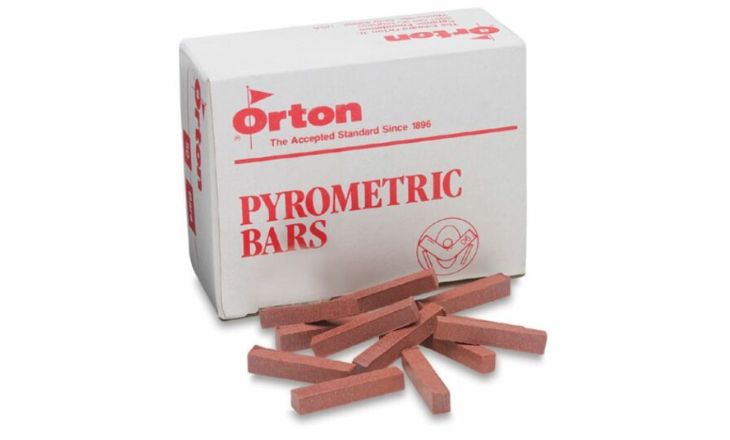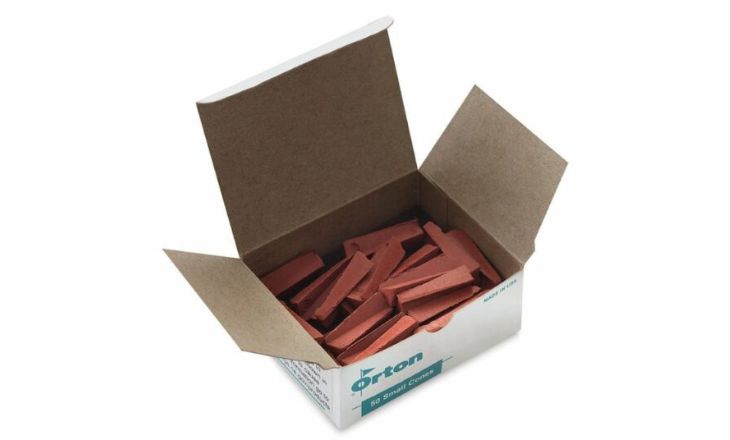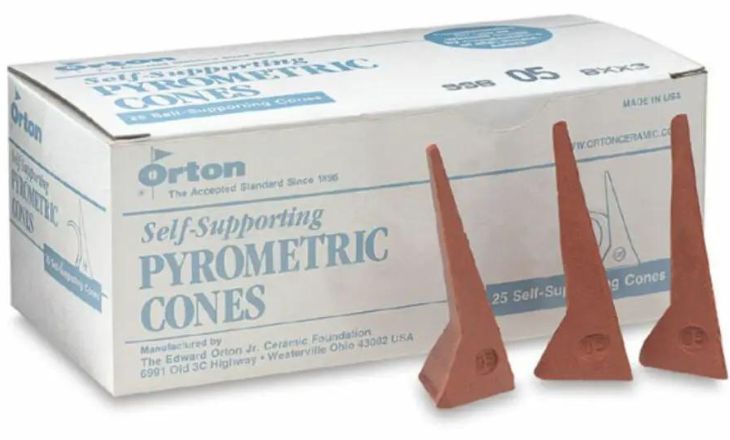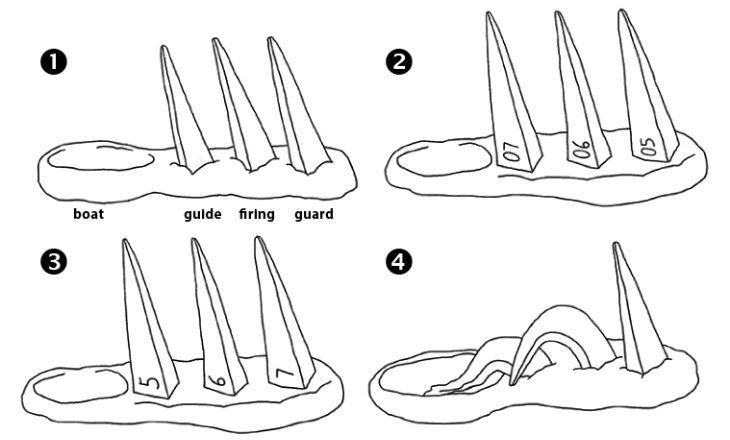Ceramics have long captured the interest of creators of art and artisans due to their rich history and variety of uses. From its role in firing kilns to its use in determining glaze maturity, the cone holds a pivotal place in the world of ceramics. The ceramic cone, a crucial tool in the kiln, acts as a temperature guide, indicating when the firing process has reached the desired level for optimal glaze and clay transformations.
The potter skillfully shaped a beautiful vase, its elegant form reminiscent of a cone, showcasing the finesse of cone pottery techniques. This article will explain the significance of cones in ceramics, whether you’re a beginner potter trying to learn the basics of fire or an expert ceramicist wishing to expand your knowledge.
What Are the Cones in Ceramics?
A cone in ceramics is a small, pyramid-shaped object made of natural materials such as clay and glaze. It serves as a temperature indicator in the kiln during the firing process. As the kiln heats up, the cone begins to bend and eventually melts, indicating that the desired temperature has been reached. With the help of this essential equipment, ceramic artists may obtain exact firing outcomes, guaranteeing the proper vitrification and durability of their creations.
Cones are the primary instrument used in the pottery industry to measure the temperature inside a kiln. Cones serve as a trustworthy gauge of heat levels in the process of creating pottery, just like a meat thermometer gives an accurate reading of the internal temperature of food.
Kiln cones, small but powerful pyrometric devices, play a vital role in ceramic firing, bending, and signaling when specific temperatures are reached to ensure precise and successful pottery outcomes.
The Different Types of Pyrometric Cones
There are different types of Pyrometric cones, including bars, standard cones, and self-supporting cones. These are small but vital instruments in pottery, that accurately gauge and record the temperature within the kiln, ensuring the precise firing needed for achieving desired glaze effects and clay transformations.
Bars
One of the most commonly used types of pyrometric cones is the Bars cone, known for its versatility and accuracy. These cones are made from carefully formulated ceramic materials that undergo specific changes in shape and form at different temperature ranges. The bar cones are usually placed alongside the ware being fired, allowing them to measure the heat work within the kiln accurately.

It’s crucial to take into consideration bar cones’ exceptional capacity to assess both temperature and time. These cones don’t require holders and can be placed directly on the kiln shelf. While kiln sitters utilize a mechanical device to shut off the kiln once the desired temperature is reached, making them a popular choice for those seeking precision and consistency in their firings.
Standard Cones
There are various varieties of pyrometric cones that fulfill distinct roles in different situations. One of the most commonly used types is the standard cone, which is made from a carefully balanced mixture of ceramic materials. This type of cone undergoes predictable changes in its shape when exposed to high temperatures in a kiln, providing an accurate indication of the heat work completed during firing.

Standard cones come in a range of numbers, each corresponding to a specific temperature and rate of heating or cooling. For example, Cone 022 indicates a lower firing temperature than Cone 10. The intricate details and variations between these standard cones allow for precise control over the firing process, ensuring consistent results for artists and potters alike.
Self Supporting Cones
One of the lesser-known types of pyrometric cones is the Self-Supporting Cone, which functions without requiring a holder. These cones are designed to bend and deform under controlled heat conditions, allowing for accurate temperature measurements within kilns. Their independence from holders makes them versatile and convenient for various firing applications.

A self-supporting cone is a specially constructed object that is essential to the firing process. These cones can endure high temperatures on their own, providing potters with a special combination of durability and practicality.
What Do the Numberd Cones Mean?
The numbered cones system, used in various industries to indicate different temperature ranges, introduces an interesting hierarchy where the lowest number corresponds to the lowest temperature and the highest number signifies the highest temperature.
The 022 cone is classified as a low-temperature cone, the 10 cone represents high-temperature firing. These cones offer potters precise control over their firing processes, ensuring that their glazes and clay bodies are fired at optimal temperatures for the desired results.
Cone values are as follows:
- 022
- 021
- 020
And they begin counting up as soon as they hit 0.
- 02
- 01
- 1
- 2
Very Low Fire
The firing range of cones between 022 to 011, with a temperature range of 1049 F to 1641 F, presents a unique challenge for ceramic artists and potters. This low firing range allows for delicate and intricate designs to be achieved, as the clay remains more porous and easily adaptable at lower temperatures. Artists can experiment with vibrant glazes and achieve subtle color variations that may not be possible at higher firing temperatures.
Low Fire
Cones 010 to 02 occupy a fascinating low firing range, offering potters and ceramic artists the opportunity to achieve unique results. This temperature range, spanning from 1636 to 2138 degrees Fahrenheit, unlocks a spectrum of creative possibilities. At these lower temperatures, glazes exhibit vibrant hues, often showcasing intricate crystalline formations and stunning color variations.
This particular temperature range starts the transformation of raw glazes into their glassy, shiny state and permits the removal of chemically associated water from the clay body. The magic happens in this transitional area, as the pieces change from delicate greenware to powerful ceramic works of art that are prepared to accept their final hues and textures.
Clay bodies become powerful and porous in this fired condition, ready to take on colors and glazes that will bring them to life.
Low-Mid Fire
In the low-mid firing range, cones 01 to 03 play a crucial role in achieving the desired results for ceramic artists and potters. At temperatures ranging from 1999 to 2052 degrees Fahrenheit, these cones help achieve a fine balance between strength and visual attractiveness.
Mid-Fire
In the mid-fire range of cones 4 to 7, potters and ceramic artists experience an exciting stage in the firing process where glazes undergo a stunning transformation. At temperatures ranging from 1999 to 2052 degrees Fahrenheit, the chemical composition of glazes reacts dynamically, creating striking visual effects on finished pieces.
The final glaze firing process is a critical stage for potters, with the most common temperature range falling between 2100°F and 2300°F. This high heat transforms raw clay and glazes into durable, beautiful finished pieces, regardless of whether you work with stoneware, earthenware, or porcelain clay.
High-Fire
Cones 8 and above are the highest points in a high firing range for ceramics. At these temperatures, around 1999 to 2052 degrees Fahrenheit, the clay body undergoes a dramatic transformation, obtaining a vitrification stage at which it solidifies and becomes resistant.
This range’s outstanding strength and heat resistance are demonstrated by the fact that it is used in an industrial fire. All ceramic components, from toilets in your home to automotive engines, go through severe firing processes to make them resistant to harmful environments.
How To Use A Pyrometric Cone
Creating a cone pack is a method of arranging multiple cones in the kiln to achieve consistent and accurate firing results. By clustering cones together, you can better monitor the temperature distribution within the kiln, ensuring even heat penetration across the entire load.

This technique is particularly useful for large or unevenly loaded kilns where temperature variation can be an issue. There are three parts to a cone pack:
Guide Cone
The first part of a cone pack is the guide cone. The complicated shape of guide cones can have a big influence on the results of your ceramic firing efforts. It’s crucial to recognize that a guide cone one value lower cooler than the optimal fire temperature and timeframe can yield unexpected results.
If you are considering firing pottery at cone 6, selecting cone 5 as your guide cone might seem strange. By choosing a slightly lower guide cone, you create an environment within the kiln that allows for more even heat distribution and decreased risk of over-firing. This increases the possibility that your parts won’t bend or alter throughout the firing process, increasing the success rate of your firings.
Firing Cone
The firing cone, often considered the holy grail of pottery and ceramic artists, holds the key to achieving the perfect firing temperature and timeframe.
Once the desired temperature and timeframe are reached, the firing cone will melt, creating an awe-inspiring transformation of the raw materials.
Guard Cone
The guard cone acts as a crucial indicator of potential threats beyond your current firing range. By being 1 level higher than your firing cone, It acts as an early warning system for you, informing you of potential threats and giving you time to make calculated strategic moves.
To assemble a cone pack, the process begins with the selection of a suitable clay lump. This lump can serve as the base and foundation for the entire pack. The next step involves shaping a boat or designated area to catch any melted material from the cones during firing.
The cone pack becomes a crucial visual indicator of the temperature inside the kiln. Its placement on any kiln shelf is strategic, as it allows the potter to monitor and adjust the firing process accordingly.
Conclusion
Cones in ceramics appear as the silent performers, skillfully and gracefully directing the conversion of raw materials into priceless works of art. It plays a crucial role in the pottery firing process, providing potters with accurate temperature measurements and ensuring that their ceramic creations are fired to perfection.
By using cones, potters can achieve consistent results and avoid under or over-firing their work. Understanding the importance of cones in kiln firing can greatly benefit potters of all skill levels, allowing them to produce high-quality ceramic pieces with confidence.
FAQs
How Do You Cone Ceramics?
To cone ceramics, cut and slam a lump of clay to remove air, fold, and rotate the resulting shape, repeating the process until the clay achieves a uniform, bubble-free consistency.
What Is The Purpose Of Coning In Pottery?
The purpose of coning in pottery is to prepare the clay for working by removing air pockets and achieving a consistent texture. Coning enhances the workability of the clay, making it more responsive to the potter’s touch.
Which Is Hotter Cone 04 Or 06?
The temperature of a cone is inversely related to its number. The Lower the cone number, the higher the temperature it represents. Therefore, Cone 04 is hotter than Cone 06.
